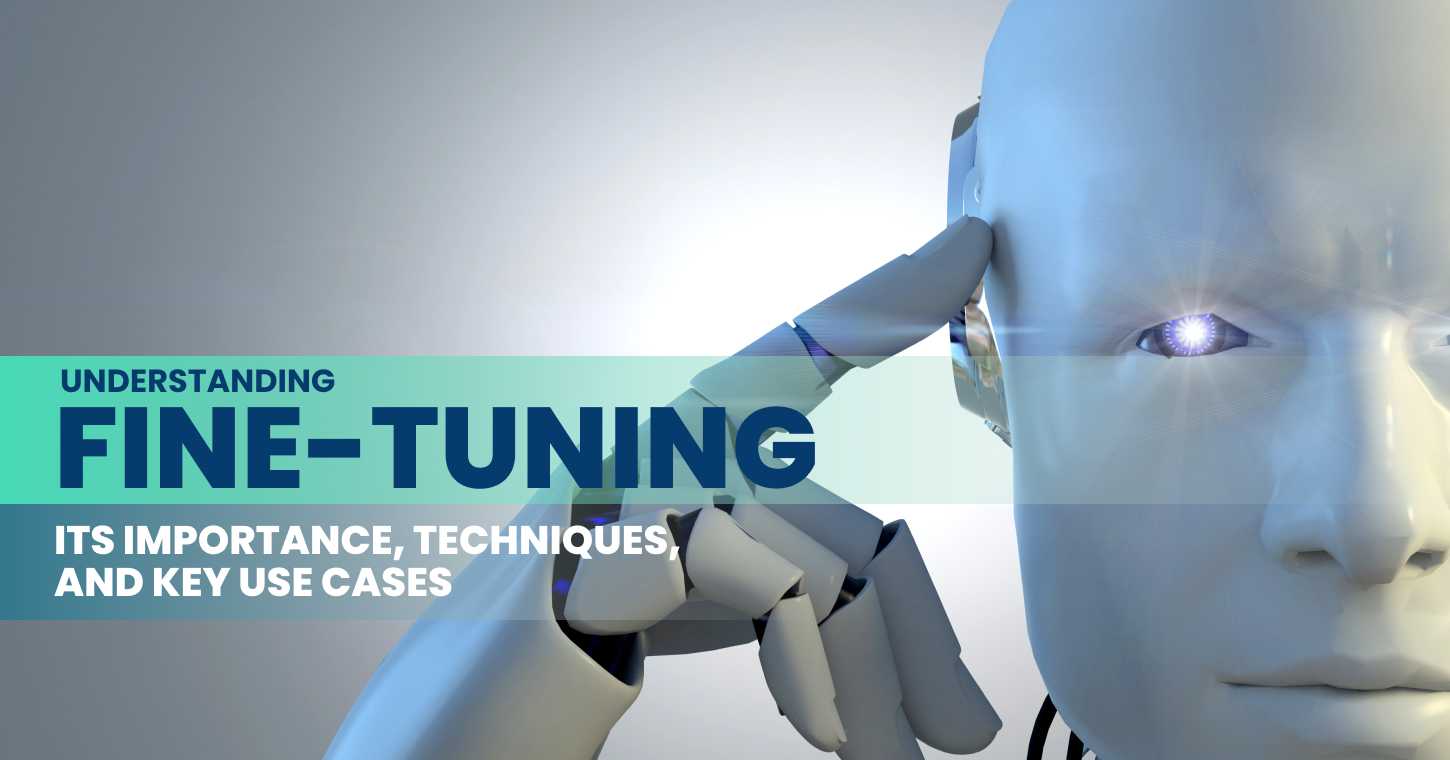Download Our Guide to Explore AI Fine-Tuning Techniques
Have you ever thought of AI models as similar to musical instruments?
Just as a violin must be fine-tuned to produce the right sound, AI models, too, require fine-tuning to deliver optimal results. This is especially true with advanced technologies like OpenAI Fine Tuning, which elevates the process to a new level.
If you’ve been scratching your head over how to get your machine-learning model to perform better, then this concept is your answer. Welcome to the intriguing world of fine-tuning AI models!
Now, imagine that you’ve just bought a violin for the first time. You’d like to play a beautiful tune, but when you pull the bow across the strings, it sounds more like a cat’s symphony than a melodious song. What’s wrong?
You quickly realize that the violin is out of tune. Fine-tuning here means adjusting the tension in the strings to reach the perfect pitch.
Similarly, in the world of AI, fine-tuning is a process that helps an already trained model perform better by adapting it to a specific task.
The model has already learned a lot, but fine-tuning is about making it learn a little more about your specific problem. Hence, fine-tuning is crucial in achieving superior results.
Let’s consider a self-driving car. A pre-trained AI model can identify roads, traffic signals, and pedestrians.
But what if you want to deploy the car in a new city with different traffic rules and road conditions?
You can’t simply expect the model to be ‘ready-to-go.’ That’s where fine-tuning steps in to adjust the model to these new conditions, ensuring safe and smooth rides.
In this article, I will be your guide in this journey, providing insights into the importance of fine-tuning, how it works, and how it can significantly improve the performance of your AI model.
Are you ready to take the plunge? Let’s get started.
Training Data and Algorithms – The Heart and Brain of AI Models
Training data plays the role of a teacher, providing the model with examples from which it learns patterns and makes predictions.
Let’s say you want your model to distinguish between pictures of dogs and cats. You’d show it tons of dog and cat pictures (your training data), and it learns to differentiate based on their features.
Meanwhile, the algorithm is the model’s brain, dictating how it learns from the data. It’s like the child’s thinking process, adjusting and learning from each new experience.
Every time the model makes a mistake, the algorithm adjusts the model’s ‘understanding’ slightly, aiming to make fewer mistakes next time. This dynamic duo of data and algorithms makes learning possible for AI models.
Pre-trained Models and Transfer Learning – The Power of Leveraging Past Knowledge
Now, imagine you’re not the first person to teach the child. They already know a few things, which gives you a head start.
This is the idea behind pre-trained models in AI. A pre-trained model has already been trained on a large dataset, usually a generic one like images or texts from the internet.
But why is that useful?
You don’t start from scratch. The model has already learned some generic features, like identifying shapes in images or sentiments in text. This is where transfer learning comes into play. It’s about transferring what the model has learned from previous training to a new task.
Consider our dog and cat example. A pre-trained model has already learned to recognize basic features like edges, colors, or shapes from a general dataset.
When you’re fine-tuning it for dogs and cats, the model doesn’t need to relearn these basics. It can focus on more specific features like the shape of ears or the pattern of fur, thereby saving time and resources.
Why is This Important?
Understanding these fundamentals is essential as they lay the groundwork for fine-tuning. When we fine-tune an AI model, we are essentially leveraging these pre-existing learnings and tweaking them to our specific needs.
The ability to do this not only saves computational resources and time but also often results in superior performance, making your model a master of your specific task.
Here’s a little recap of what we’ve learned so far:
- Training data and algorithms: The duo that enables AI models to learn and grow, similar to how a child learns from experiences.
- Pre-trained models: These models come with a head start, having been trained on a large, generic dataset.
- Transfer Learning: This concept allows us to use what a model has already learned and apply it to a new task, saving time and resources.
So far, so good? Alright, let’s carry this momentum forward and dive deeper into the process of fine-tuning.
Check Mastering The Art Of Prompting: Best Practices And Powerful Commands For Generative AI.
The Art of Fine-Tuning: Adapting and Updating
Let’s say we’re working on an AI model to identify specific bird species. We could start with a pre-trained model that recognizes generic objects, and then we fine-tune this model with images and information about our specific bird species.
This way, we’re teaching the model to focus on the characteristics unique to our task.
Next comes updating the model weights. In the realm of AI, weights are parameters within the model that have been learned from training data. They determine the model’s output for a given input.
So when we fine-tune, we adjust these weights based on our new, additional training data – our bird pictures.
Remember, the goal is not to completely retrain the model from scratch but to make small tweaks based on the new data.
It’s like having an experienced chef learn a new recipe – they already know the basics; they just need to master the new ingredients and steps.
The Sweet Benefits of Fine-Tuning
So, why go through this process of fine-tuning? Because the benefits are worth it!
- Improved Performance and Accuracy: Fine-tuning allows our model to get a deeper understanding of our specific task, improving its ability to predict or classify accurately.
- Faster Training Times and Reduced Computational Resources: Since we’re not training our model from scratch and the model already has a basic understanding, we save a lot of time. This also means less computing power and resources are needed, making the process cost-effective.
With a good understanding of what fine-tuning is and why it’s important, let’s move on to the actual process: selecting a suitable pre-trained model.
Choosing Your Champion: The Pre-Trained Model
In the world of AI, there are a myriad of pre-trained models available. Your task is to pick the one that best fits your specific needs.
So, how do you make the right choice?
First, assess the compatibility of the model with your target task or domain. If your task involves images, a model trained on text data won’t be very helpful.
If you’re dealing with language data, a pre-trained model on a large text corpus like BERT or GPT would be a better choice.
Keep in mind the characteristics of your data as well. If your images are black and white, a model pre-trained on colored images may not be the best fit.
The key here is to look for models that have been trained on data similar to yours or at least on data that has similar characteristics.
Next, you’d want to compare different model architectures and their strengths. Just as different vehicles are suited for different terrains, different model architectures are optimized for different tasks.
For instance, Convolutional Neural Networks (CNNs) are great for image-related tasks due to their ability to recognize spatial patterns. On the other hand, Recurrent Neural Networks (RNNs) excel in handling sequential data like time series or text.
But it doesn’t stop there. Even within each type, there are variations. For CNNs, you have options like ResNet, Inception, and more.
Each architecture has its strengths and trade-offs in terms of accuracy, speed, and resource consumption.
Here’s a quick recap:
- Assess compatibility: Choose a pre-trained model that’s compatible with your task or domain. Remember, a screwdriver won’t be of much help when you need to hammer a nail!
- Compare architectures: Different architectures are suited for different tasks. It’s like choosing between a car, a bike, or a truck, depending on your need for speed, maneuverability, or load capacity.
Selecting a suitable pre-trained model is an essential first step in the fine-tuning process. It sets the stage for the subsequent steps.
So, take your time, assess your needs carefully, and make an informed choice.
Gathering Data: The Hunt for Domain-Specific Data
Your first task is to gather domain-specific data for fine-tuning. This data should closely represent the problem you’re trying to solve.
Let’s say you’re fine-tuning a model to predict weather patterns for a particular region. In that case, you’d need historical weather data from that specific area.
Keep in mind that the more representative your data is, the better your model will understand your problem. However, gathering data can sometimes feel like a treasure hunt.
It could come from various sources: online databases, manual collection, user-generated content, and many others. The challenge lies in finding the right kind of data in sufficient quantity.
Data Preprocessing and Formatting: Getting the Data Ready
Once you’ve gathered your data, it’s time to get it in shape. In the preprocessing phase, you clean and format your data.
You’ll need to handle missing or incorrect data and possibly normalize numerical data. If you’re dealing with text, you might need to remove stop words or apply stemming.
In the formatting phase, you’ll adjust your data to the input format required by your chosen pre-trained model. For instance, you might need to resize images, tokenize text, or one-hot encode categorical data.
Now, let’s pivot to the final and most exciting step – fine-tuning the model. It’s time to turn up the heat and start cooking!
Adjusting Parameters: Fine-Tuning the Knobs
With your pre-trained model selected and your data prepped you’re ready to begin fine-tuning. This process involves adjusting the model parameters and learning rate.
The learning rate is crucial as it determines how much the model changes in response to the error it observed on the new data. A too-high learning rate might make your model unstable, while a too-low one might make the learning process painfully slow.
It’s about finding that sweet spot.
It guides the optimization process as it learns from the data. Specifically, the learning rate controls the step size during the iterative process of finding a model’s optimal parameters.
Imagine you’re in a dark room, trying to find a way out. Each step you take is based on the little information you have about your surroundings. In this scenario, your learning rate determines the size of your steps.
If you take big leaps (high learning rate), you might stumble upon the exit quickly, but you’re also more likely to miss it and keep bouncing around the room.
Conversely, if you move too cautiously (low learning rate), taking tiny steps, it might take a very long time before you find the door.
So, the learning rate represents a crucial trade-off. Ideally, you want a learning rate that is just right: large enough that the model learns efficiently and finds a good solution quickly but not so large that the model overshoots the solution and fails to converge.
Download Our Guide to Explore AI Fine-Tuning Techniques
Training the Model: The Actual Cooking
Now you’ll feed your prepared data into the model. The model will make predictions and compare them with the actual data to calculate the error.
It will then adjust its parameters slightly to reduce this error, repeating the process until it can’t improve any further or you’ve reached a predefined number of iterations.
Monitoring and Evaluating: Keeping an Eye on the Dish
As your model trains, it’s essential to monitor its performance. You want to ensure that it’s learning effectively and not just memorizing the training data (overfitting) or failing to capture the patterns in the data (underfitting).
Once the model is trained, you evaluate its performance using a separate test dataset. You might use metrics like accuracy, precision, recall, or F1 score, depending on your task.
- Accuracy: This is the most intuitive performance measure. It’s simply the ratio of correctly predicted observations to the total observations. While it’s a good measure to start with, it’s not the best choice when classes are imbalanced (when the number of observations in different classes varies greatly).
- Precision: Precision is the ratio of correctly predicted positive observations to the total predicted positive observations. High precision relates to a low false positive rate. It gives you the answer to the question: of all the classes we predicted as positive, how many are actually positive?
- Recall (Sensitivity): Recall is the ratio of correctly predicted positive observations to all observations in the actual class. The high recall relates to a low false negative rate. It answers the question: of all the actual positive classes, how many did we correctly predict?
- F1 Score: F1 Score is the weighted average of Precision and Recall. It tries to find the balance between precision and recall. This is particularly useful when dealing with imbalanced classes, as it looks at both false positives and false negatives.
Here’s how we can interpret them:
- High Accuracy, Precision, Recall, and F1-Score: This is the ideal scenario, indicating that the model has excellent performance.
- High Precision, Low Recall: This indicates that the model predicted the positive class well but missed out on many actual positive instances.
- Low Precision, High Recall: This means that the model correctly identifies the positive class, but it also includes lots of false positives.
- Low F1-Score: This could happen if either precision or recall is low. It might mean that the model is not balancing false positives and false negatives well.
Each of these metrics provides a different perspective on the performance of the model, and understanding them can guide us to adjust our model or choose a different approach.
Having traversed through the process of fine-tuning, let’s pause and reflect on why this journey is worth it. What makes fine-tuning such an essential step in the AI world?
Well, it’s all about overcoming limitations and boosting performance.
Overcoming Limitations: Giving the AI Models a Customized Edge
Generic AI models, although useful, come with their own set of constraints.
How does it work?
First, fine-tuning helps address domain-specific nuances and requirements. A generic model may be well-versed in general patterns, but when it comes to specific domains, it may fail to catch the intricacies.
If you want an AI model to understand medical jargon, it would be advantageous to fine-tune it using relevant medical texts.
Second, fine-tuning can reduce the risks of overfitting and underfitting. Overfitting is when your model is a tad too enthusiastic and learns the training data by heart, failing to generalize to unseen data.
Underfitting, on the other hand, is like a student who didn’t study enough for the exam, failing to capture the patterns in the data. By fine-tuning with the right amount of domain-specific data, you strike a balance, enabling the model to perform well on both training and unseen data.
Enhancing Performance: Making AI Models More Powerful
Apart from overcoming limitations, fine-tuning plays a crucial role in enhancing the overall performance of AI models.
How does fine-tuning boost performance?
It achieves higher accuracy and relevance. By training on domain-specific data, the model becomes more knowledgeable about your particular problem, improving its ability to make accurate predictions.
Imagine learning a new language; the more you practice (or fine-tune), the better you get.
Fine-tuning tailors models to specific business needs and objectives. Let’s say you run an online bookstore, and you want to recommend books to customers based on their reading history.
A fine-tuned model, trained on your specific book data, would be able to provide more relevant recommendations than a generic model.
To recap:
- Overcoming limitations: Fine-tuning addresses domain-specific nuances and reduces the risks of overfitting and underfitting.
- Enhancing performance: It helps achieve higher accuracy and tailors models to specific business needs.
It’s time to take off our theoretical caps and step into the exciting world of practical applications.
Let’s see how fine-tuning is making waves in various fields, turning generic models into specialized wizards!
Natural Language Processing (NLP): Fine-Tuning for Tailored Linguistics
Natural Language Processing is like teaching a machine to understand and communicate in human language.
But human language is a complex beast, with its nuances and domain-specific lingo. That’s where fine-tuning works its magic.
Sentiment Analysis in a Specific Industry
Consider sentiment analysis, where AI gauges whether a text expresses positive, negative, or neutral sentiment.
Now, a generic model might understand everyday language pretty well. But what if you want to analyze customer reviews in a niche sector, like craft beers?
Here, fine-tuning plays a crucial role. By training the model on a collection of craft beer reviews, it’ll learn industry-specific terms and sentiments (like “hoppy taste” or “malty finish”).
This way, you get more accurate sentiment analysis tailored for the craft beer industry.
Named-Entity Recognition for Specialized Vocabularies
Another intriguing use case is named-entity recognition (NER), where the AI identifies and classifies names in a text (like persons, organizations, and locations). Now, a generic model might stumble when it encounters specialized vocabularies, say, in a medical or legal text.
Fine-tuning to the rescue! By training the model with relevant texts, it learns to recognize specialized entities (like medical terms or legal jargon), significantly enhancing its NLP capabilities.
Computer Vision: Fine-Tuning for a Clearer View
Computer Vision aims to replicate human vision, teaching machines to ‘see’ and interpret visual data. Yet, every visual domain has unique attributes, making fine-tuning an essential step.
Object Detection in Specific Environments or Contexts
Let’s take object detection, where the AI identifies and locates objects in an image. Suppose you want a model to detect cars in a parking lot security feed.
A generic model could identify cars, sure, but it might struggle with different lighting conditions or car orientations unique to your feed.
Here, fine-tuning the model with images from the specific parking lot can vastly improve its detection accuracy. It’ll become a seasoned parking lot surveillance expert, spotting cars regardless of their tricky parking spots or the moody weather!
Image Segmentation for Customized Applications
In image segmentation, the AI classifies each pixel in an image, effectively partitioning it into multiple segments. Now, imagine you’re developing a customized app that detects and segments different types of trees in a forest for ecological research.
A generic model might not have sufficient expertise in arboreal image segmentation. But fine-tune it with images of different tree species in various light and weather conditions, and voila! Your model now excels in its tree-detecting task.
Recommendation Systems: Fine-Tuning for Personalized Suggestions
Recommendation systems are like personal assistants, suggesting items you might like based on your behavior. Yet, every user and business is unique, necessitating a fine-tuned approach.
Personalized Content Recommendations
For instance, consider a news app wishing to provide personalized content to users. A generic model might recommend articles based on general popularity. But fine-tune it with the user’s reading history, and the model can suggest articles aligned with individual preferences.
Tailored Product Recommendations
Similarly, in e-commerce, a fine-tuned model can provide tailored product recommendations. By training on user browsing and purchasing history, the model understands individual tastes, making its suggestions more relevant and compelling.
In conclusion:
- NLP tasks: Fine-tuning helps with sentiment analysis in specific industries and named-entity recognition for specialized vocabularies.
- Computer vision tasks: It enhances object detection in specific environments and image segmentation for custom applications.
- Recommendation systems: Fine-tuning enables personalized content and product recommendations.
From deciphering craft beer reviews to recognizing trees in a forest, fine-tuning is the key that unlocks AI’s potential to cater to unique requirements.
So, next time you’re looking to employ AI, remember that a bit of fine-tuning can go a long way! Stay tuned for our concluding thoughts in the next section.
Fine-Tuning for Customized, High-Performance Solutions
We’ve journeyed together through the world of fine-tuning AI models, from understanding its nuances to witnessing its power in action.
In this vast universe of artificial intelligence, fine-tuning is the compass that guides AI models and their underlying neural networks to their destination of optimal performance.
It’s this customized edge, achieved by adjusting the pre-trained weights, that elevates models from being ‘generically good’ to ‘specifically fantastic’!
Here’s what we learned about the art of fine-tuning:
- It addresses domain-specific nuances and requirements, letting AI models become fluent in the language of your specific field.
- It minimizes the risks of overfitting and underfitting, ensuring your model isn’t too rigid or too lax but just right.
- It improves accuracy and relevance, tailoring models to meet specific business needs and objectives.
By adapting pre-existing AI models to your unique tasks, you leverage the power of transfer learning while saving valuable time and computational resources. It’s a win-win situation!
Remember, the best AI model for you is the one that understands your needs.
So venture forth, let this knowledge of fine-tuning guide you, and may your journey in the domains of AI be thrilling and effective!









